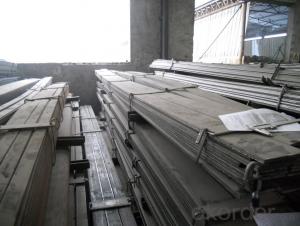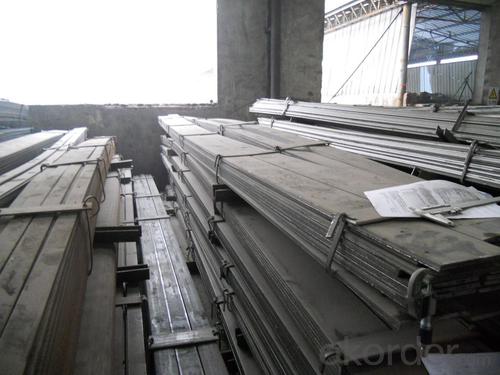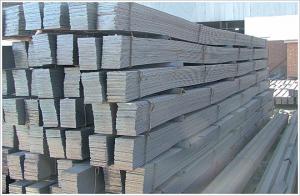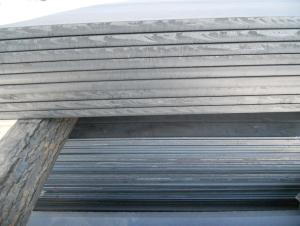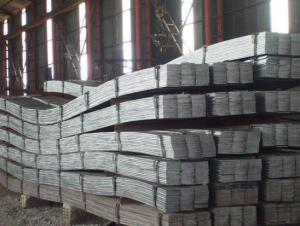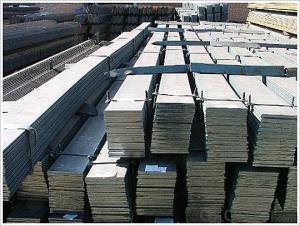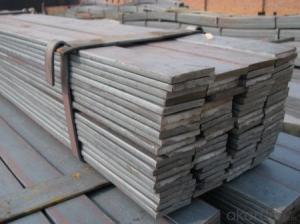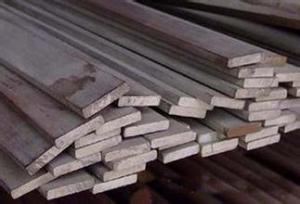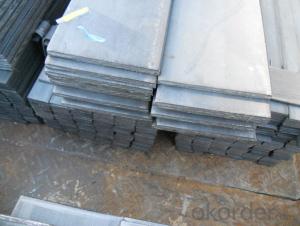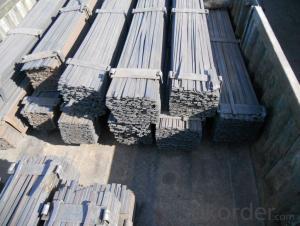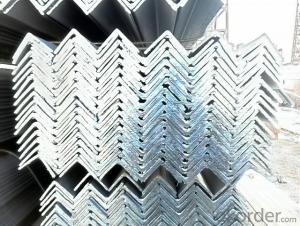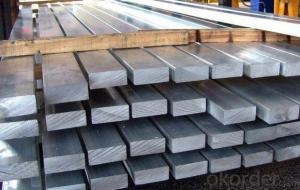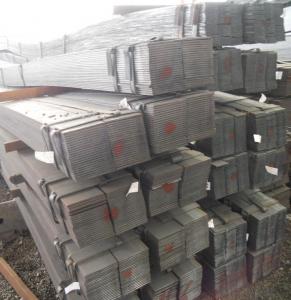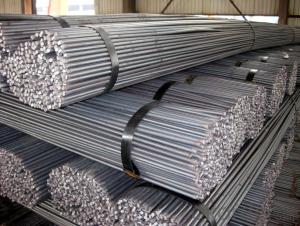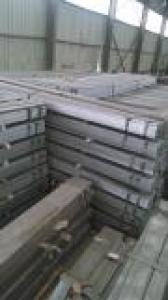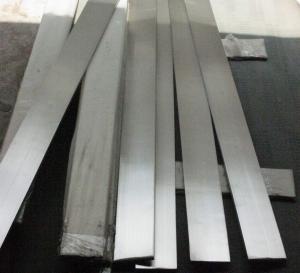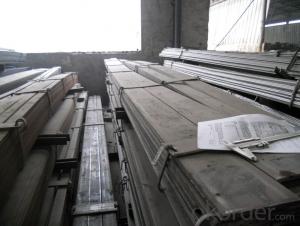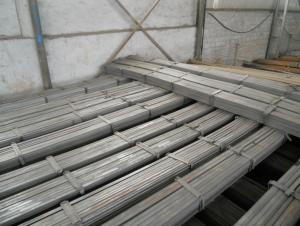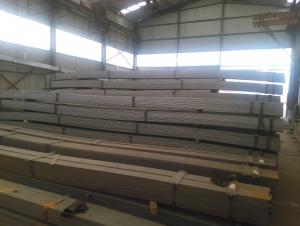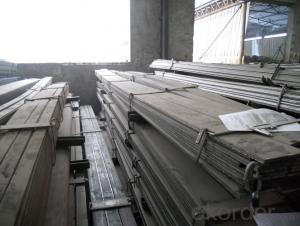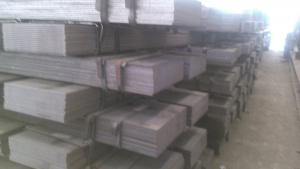Q235 Stainless Steel Flat Bar of Standard: GB
- Loading Port:
- Tianjin
- Payment Terms:
- TT OR LC
- Min Order Qty:
- 25 m.t.
- Supply Capability:
- 1000 m.t./month
OKorder Service Pledge
OKorder Financial Service
You Might Also Like
Product Applications:
Q235 Stainless Steel Flat Bar of Standard: GB are ideal for structural applications and are widely used in the construction of buildings and bridges, and the manufacturing, petrochemical, and transportation industries.
Product Advantages:
OKorder's Q235 Stainless Steel Flat Bar are durable, strong, and resist corrosion.
Main Product Features:
· Premium quality
· Prompt delivery & seaworthy packing (30 days after receiving deposit)
· Corrosion resistance
· Can be recycled and reused
· Mill test certification
· Professional Service
· Competitive pricing
Specification of Q235 Steel Flat Bar
Commodity: Q235 Steel Flat Bar
Standard: GB
Material: Q235
Brand name: FLATSPACE
Origin place: China
Thickness: 3mm-30mm
Width:20mm-200mm
Length: Max 12m
Certification: SGS/BV
Chemical composition of Q235
Alloy No | Grade | Element(%) | ||||
C
| Mn
| S
| P
| Si
| ||
Q235
|
B
|
0.12—0.20 |
0.3—0.7 |
≤0.045 |
≤0.045
|
≤0.3
|
Physical properties of Q235
Alloy No | Grade | Yielding strength point(Mpa) | Tensile strength (Mpa) | Elongation after fracture(%) | ||||||
Thickness (mm) | Thickness (mm) | |||||||||
≤16 | >16--40 | >40--60 | >60--100 | ≤16 | >16--40 | >40--60 | >60--100 | |||
≥ | ≥ | |||||||||
Q235 |
B |
235 |
225 |
215 |
205 |
375--500 |
26 |
25 |
24 |
23 |
Usage/Applications of Q235 Steel Flat Bar
Widely used for construction, Machinery manufacturing, Iron tower steel structure, Shipbuilding; Steel grating, Staircase, Bridge, Viaduct, Railway spare parts, Boilers making etc.
Production Flow of Q235 Steel Flat Bar
The steel flat bar is made through three processes:
1.Feeding the material: Feeding the row material (the steel plate) to Slitting Line.
2.Slitting:The steel plate would be slitted into expected width by lengthways cutter.
3. Leveled and cutting: The plat bar would be ground into level by the grinder and then cut into required length.
Packaging & Delivery of Q235 Steel Flat Bar
Packaging Details: The Steel Flat Bars are packed in bundles and loaded in 20 feet/40 feet container, or shipped by bulk cargo ,also we can do as customer's requirements.
Delivery Details:30~45 days upon the receipt of buyer payment by T.T. or L/C.
FAQ:
Q1: Why buy Materials & Equipment from OKorder.com?
A1: All products offered byOKorder.com are carefully selected from China's most reliable manufacturing enterprises. Through its ISO certifications, OKorder.com adheres to the highest standards and a commitment to supply chain safety and customer satisfaction.
Q2: How do we guarantee the quality of our products?
A2: We have established an advanced quality management system which conducts strict quality tests at every step, from raw materials to the final product. At the same time, we provide extensive follow-up service assurances as required.
Q3: What makes stainless steel stainless?
A3: Stainless steel must contain at least 10.5 % chromium. It is this element that reacts with the oxygen in the air to form a complex chrome-oxide surface layer that is invisible but strong enough to prevent further oxygen from "staining" (rusting) the surface. Higher levels of chromium and the addition of other alloying elements such as nickel and molybdenum enhance this surface layer and improve the corrosion resistance of the stainless material.
Q4: Can stainless steel rust?
A4: Stainless does not "rust" as you think of regular steel rusting with a red oxide on the surface that flakes off. If you see red rust it is probably due to some iron particles that have contaminated the surface of the stainless steel and it is these iron particles that are rusting. Look at the source of the rusting and see if you can remove it from the surface
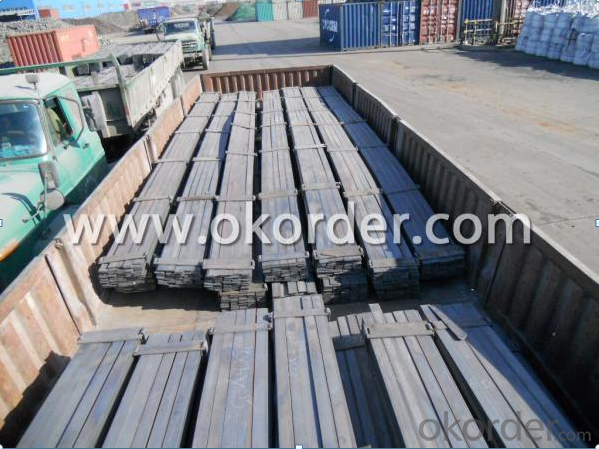
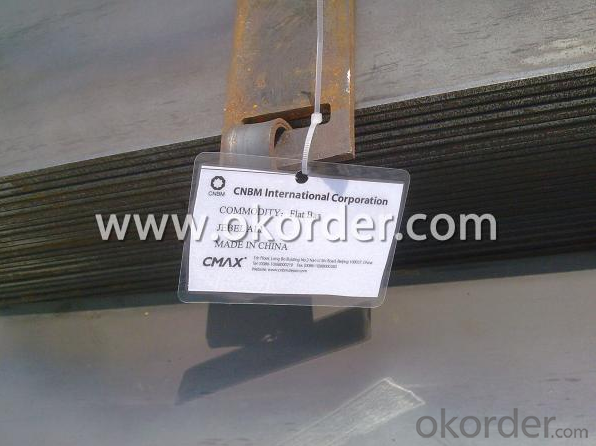
- Q: Are steel flat bars suitable for architectural detailing?
- Architectural detailing can indeed benefit from the use of steel flat bars. These bars possess numerous advantages that contribute to their popularity in architectural applications. Firstly, steel boasts exceptional strength and durability, ensuring the longevity and stability of architectural structures. By utilizing steel flat bars, intricate designs and patterns can be achieved, enhancing the unique aesthetic appeal of buildings. Furthermore, steel flat bars offer versatility and ease of customization, allowing them to meet specific architectural requirements. Architects can effortlessly cut, bend, and shape these bars into various sizes and angles, enabling the creation of innovative and intricate designs. Consequently, steel flat bars find utility in architectural detailing for elements such as handrails, staircases, window frames, door frames, balustrades, and decorative trims. Moreover, these bars provide reliable structural support, making them suitable for load-bearing applications. They can effectively reinforce concrete structures, providing additional strength and stability. Additionally, steel flat bars display excellent resistance to corrosion, making them ideal for architectural detailing in outdoor or high-moisture environments. In conclusion, the strength, durability, versatility, and aesthetic appeal of steel flat bars make them an excellent choice for architectural detailing. Architects and designers can confidently rely on these bars to create visually appealing and structurally robust architectural elements.
- Q: What is the appearance of hot galvanizing and cold galvanized flat steel?
- Cold galvanizing is zinc plating, the amount of zinc plating is very little, only 10 - 50g/m2, and its corrosion resistance is much different from that of galvanized pipe. Regular galvanized pipe manufacturer, in order to ensure quality, most do not use electro galvanized (Leng Du). Only small enterprises with small equipment and old equipment use zinc plating, of course, their prices are relatively cheaper. At present, the Ministry of construction has officially completed the following, the elimination of backward cold galvanized pipe, the future is not allowed to use cold galvanized pipe for water, gas pipes.
- Q: What are the different packaging options available for steel flat bars?
- The different packaging options available for steel flat bars include bundled packaging, wooden crates, steel frames, or custom packaging based on specific customer requirements.
- Q: What are the different methods of surface sanding for steel flat bars?
- There are several methods of surface sanding for steel flat bars, including hand sanding, machine sanding with sandpaper or abrasive belts, and using power tools such as sanders or grinders.
- Q: What are the maximum load capacities of steel flat bars?
- The load capacity of steel flat bars can vary based on factors such as bar dimensions, steel type and grade, and the method of applying the load. Steel flat bars are widely used in construction, manufacturing, and industrial settings due to their strength and versatility. The load capacity of a steel flat bar is typically determined by its bending and tensile strength. Bending strength refers to the maximum stress the bar can handle before permanently bending or deforming, while tensile strength is the maximum stress it can handle before breaking or fracturing. Engineers and designers often rely on standardized tables, graphs, and engineering codes to determine the load capacity of a specific steel flat bar. These resources provide information on the maximum allowable loads for different bar sizes and steel grades. For instance, a 1-inch by 1/4-inch steel flat bar made from mild steel may have a maximum load capacity of approximately 3,000 pounds when supported at both ends and evenly distributed along its length. However, this value can vary depending on the specific steel grade and quality. To ensure the safe and optimal use of steel flat bars, it is important to consult reliable sources and consider the specific application requirements. Seeking the advice of a structural engineer or referring to relevant engineering codes and standards is highly recommended.
- Q: What are the different surface treatments for steel flat bars?
- There are several different surface treatments available for steel flat bars. These treatments are applied to enhance the appearance, protect against corrosion, improve the durability, and provide specific functionalities to the steel flat bars. Some of the common surface treatments for steel flat bars include: 1. Hot-dip galvanizing: This process involves immersing the steel flat bars in a bath of molten zinc. The zinc bonds with the steel, forming a protective coating that prevents corrosion. Hot-dip galvanizing is highly effective in outdoor applications where the steel is exposed to moisture, chemicals, and harsh weather conditions. 2. Powder coating: Powder coating is a dry finishing process that involves applying a fine powder made of resin and pigments onto the steel flat bars. The bars are then heated, causing the powder to melt and form a durable, decorative, and corrosion-resistant coating. Powder coating offers a wide range of colors and finishes, making it popular for aesthetic purposes. 3. Electroplating: Electroplating is a process that involves coating the steel flat bars with a layer of metal through an electrochemical process. Common metals used for electroplating include chrome, nickel, and zinc. Electroplating can enhance the appearance, provide corrosion resistance, and improve wear resistance of the steel flat bars. 4. Passivation: Passivation is a chemical treatment used to remove iron particles and contaminants from the surface of stainless steel flat bars. This process improves the corrosion resistance of the stainless steel by creating a protective oxide layer that prevents rusting. 5. Anodizing: Anodizing is commonly used for aluminum flat bars but can also be applied to steel flat bars. This process involves creating a controlled oxide layer on the surface of the metal through an electrochemical process. Anodizing improves the corrosion resistance, hardness, and appearance of the steel flat bars. 6. Painting: Painting is a common surface treatment for steel flat bars, especially for indoor applications. The bars are coated with a layer of paint that provides an attractive finish while also protecting against corrosion. Paint can be applied in various colors and finishes to meet specific aesthetic requirements. It is important to consider the specific application and environment when choosing a surface treatment for steel flat bars. Each treatment offers unique benefits and characteristics that can be tailored to meet the desired appearance, performance, and durability requirements.
- Q: Are steel flat bars suitable for making electrical machinery or equipment?
- Depending on specific requirements and application, steel flat bars can be used for electrical machinery or equipment. Steel provides several benefits, including high strength, durability, and excellent conductivity, which are advantageous for electrical applications. However, it is important to consider factors such as electrical conductivity, magnetic properties, and corrosion resistance when choosing the right steel flat bars for electrical machinery. In certain situations, copper or aluminum may be preferred over steel due to their superior electrical conductivity. Furthermore, the design and construction of the machinery or equipment must comply with relevant electrical safety standards and regulations to ensure proper functionality and protection against electrical hazards.
- Q: Can steel flat bars be used in the oil and gas industry?
- Yes, steel flat bars can be used in the oil and gas industry. Steel flat bars are versatile and commonly used in various industries due to their strength and durability. In the oil and gas industry, steel flat bars are utilized for a wide range of applications such as supports, frames, platforms, and structural components. These bars are often made from carbon steel or alloy steel, which provide excellent resistance to corrosion, high temperatures, and pressure. Additionally, steel flat bars can be easily welded and fabricated to meet specific project requirements, making them a suitable choice for the oil and gas industry.
- Q: What are the standard tolerances for straightness in steel flat bars?
- The standard tolerances for straightness in steel flat bars vary depending on the specific industry and application. However, in general, the common tolerance range for straightness in steel flat bars is typically within 0.25% to 0.5% of the total length of the bar.
- Q: Can steel flat bars be used for fencing or railing?
- Indeed, fencing or railing can benefit from the utilization of steel flat bars. These bars, renowned for their robustness and longevity, are frequently employed in construction endeavors. As pickets for fences or balusters for railings, they fulfill their purpose admirably. The bars' flat configuration facilitates effortless installation while exuding a contemporary and sophisticated aesthetic. Moreover, personalizing steel flat bars to harmonize with specific designs is a breeze, and safeguarding against rust and corrosion can be achieved through painting or coating. In summary, the durability and adaptability of steel flat bars render them an optimal choice for fencing or railing undertakings.
Send your message to us
Q235 Stainless Steel Flat Bar of Standard: GB
- Loading Port:
- Tianjin
- Payment Terms:
- TT OR LC
- Min Order Qty:
- 25 m.t.
- Supply Capability:
- 1000 m.t./month
OKorder Service Pledge
OKorder Financial Service
Similar products
Hot products
Hot Searches
Related keywords
